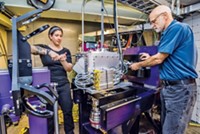Advertisement
Grab your lab coat. Let's get started
Welcome!
Welcome!
Create an account below to get 6 C&EN articles per month, receive newsletters and more - all free.
It seems this is your first time logging in online. Please enter the following information to continue.
As an ACS member you automatically get access to this site. All we need is few more details to create your reading experience.
Not you? Sign in with a different account.
Not you? Sign in with a different account.
ERROR 1
ERROR 1
ERROR 2
ERROR 2
ERROR 2
ERROR 2
ERROR 2
Password and Confirm password must match.
If you have an ACS member number, please enter it here so we can link this account to your membership. (optional)
ERROR 2
ACS values your privacy. By submitting your information, you are gaining access to C&EN and subscribing to our weekly newsletter. We use the information you provide to make your reading experience better, and we will never sell your data to third party members.
Analytical Chemistry
Separating isotopes via surface diffraction
Molecular beam scattering method offers simple route to isotope enrichment
by Mitch Jacoby
October 30, 2017
| A version of this story appeared in
Volume 95, Issue 43
Isotope separation methods are key to numerous scientific and industrial processes. Nuclear power plants and weapons, for example, require fuels enriched in a select isotope. And isotopically pure or enriched samples are used in scientific research and medical procedures. Isotopes can be separated via fractional distillation, gaseous diffusion, and centrifugation. The process can also be driven by chemical, magnetic, and electrostatic methods. But these techniques are often energy intensive and require many sequential separation steps. Kevin J. Nihill, Jacob D. Graham, and Steven J. Sibener of the University of Chicago have come up with a potentially simpler method based on surface diffraction. The team reports that when a beam of neon strikes a methyl-capped silicon crystal, a portion of the beam diffracts, scattering 20Ne and 22Ne isotopes into beams that emerge at slightly different angles (Phys. Rev. Lett. 2017, DOI: 10.1103/PhysRevLett.119.176001). A single pass causes 22Ne, the less abundant isotope, to be enriched by a factor of 3.5. A higher degree of separation can be achieved by using additional diffraction steps or by exploiting mass-based differences in the isotopes’ velocities, the team suggests.



Join the conversation
Contact the reporter
Submit a Letter to the Editor for publication
Engage with us on Twitter